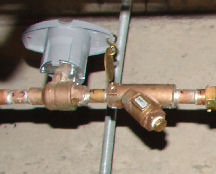Newfound water risk: Lead-leaching valves
Despite having 'leadfree' brass, some fittings in school's drinking water lines shed high amounts of the heavy metal.
Hidden elements in drinking-water lines can shed large amounts of lead, a toxic heavy metal. And it’s quite legal, even if it does skirt the intent of federal regulations.

University researchers, who uncovered this problem the hard way, have published a case study on the offending hardware in the November issue of the journal of the American Water Works Association.
Lead adds ductility to brass, making it easier to bend or machine into desired shapes. To limit the risk of lead poisoning, U.S. law prohibits new brass plumbing parts in drinking water lines from containing more than 8 percent lead by weight. Yet two shut-off valves containing only about 6.5 percent lead leached toxic amounts of the metal into drinking fountains at the University of North Carolina.
What happened: During manufacturing, the lead did not uniformly distribute throughout the brass, but ended up preferentially settling at or near the surface. As a result, the outside of affected valves — the side visible when looking at a water line (see photo) — slightly exceeded the lead limit. That shouldn’t have posed a health problem, since this surface doesn’t touch water. However, the valves’ interior surface, which does, contained at least 18 percent lead by weight.
As brass alloys cool, “the lead can crystallize preferentially at surfaces,” explains Marc Edwards, a Virginia Tech engineering professor who has a reputation for solving challenging water-quality puzzles. He is also an author of the new paper. In addition, Edwards notes, “if the [brass] surfaces are cut, the lead in the alloy gets ‘smeared’ all over the surface like a coat of paint.”
The new valve data are just the latest lead problem turned up by Edwards’ crew and Carolyn Elfland, an associate vice chancellor at the University of North Carolina at Chapel Hill.
Two years ago, Elfland recounted in this blog how the drinking water lines in new buildings on her campus had been leaching high concentrations of lead — and how Edwards was able to help her trace the problem to various “leadfree” faucets that she had purchased.
After a year of investigations and measurements, the pair thought they had solved the problem. They flushed each newly installed “leadfree” plumbing fixture with water for one to three days — nonstop. Then they removed any lead crystals that had collected in downstream faucet aerators or fountains and confirmed this conditioning procedure worked (by testing the water for lead).
Despite being cumbersome and rather costly — $49 to $91 per treated fixture, depending on the seasonal price of UNC’s water — this procedure worked spectacularly for a year. Until tests uncovered two water fountains that resisted treatment.
Federal drinking water standards limit lead to no more than 15 parts per billion. One of the treated fountains was consistently delivering water with 30 ppb or more lead; the other’s water contained more than 100 ppb.
“We reflushed the fountains,” Elfland says, and the worst offender still issued water with 80 ppb lead. More puzzling: The second one now issued water with more lead than before. “We’d never seen that,” she says.
So she called the manufacturer and asked if there were any strainers inside the fountains that might be able to collect lead particles. There were. And when the university plumbers pulled them out, “they were just totally clogged with lead. Yea,” Elfland recalls thinking. “Problem solved.”
Except it wasn’t.
After cleaning out the strainer, the fountain’s water now had more lead than before. Tests would show the lead value was actually high in water entering the fountain. So Edwards sent a colleague to UNC armed with a device (an X-ray fluorescence spectrometer) that could assay lead concentrations in plumbing hardware, in place, without destroying the brass.
Paolo Scardina checked the solder at joints in the piping — and that wasn’t the source. So he probed further up the line. And that’s where he found the now-infamous water-shutoff valves.
UNC replaced both fittings and lead levels plummeted. But still unanswered were why the initial fittings had leached so much lead.
Scardina took the valves back to Virginia Tech where they were cut into pieces and eventually melted down for further analysis. Along the way, Elfland soaked some valving wafers in water to see how long they’d continue to leach lead. When they hadn’t stopped by 16 weeks, she gave up counting.
To find out whether these were just two anomalous valves, she had Edwards’ team back out to apply their nondestructive testing to another 126 ball valves that UNC had recently installed in new buildings. And 22 percent of these brass parts — including units from three different manufacturers — had greater than 8 percent lead, by weight, on their exterior surfaces. Since Elfland didn’t pull them out, she’s not sure how high concentrations were on their inner surfaces.
The shed lead ultimately collected in faucet aerators and fountain strainers as tiny particles — shards of metal that would continue to taint any water passing over it. Why the leached lead is precipitating out this way will be the subject of a follow-up paper, Edwards says.
In the mean time, Elfland has calculated how much time it took her team to identify the problem associated with two $20 valves. Assuming standard labor charges for commercial plumbers (had she not been able to employ the salaried individuals on her staff) and all analytical fees, the total came to a whopping $30,000.
And there was nothing special about these valves, she notes. They could have been used in homes.
“If truly leadfree valves were available they might cost more, but I’d buy them,” Elfland said. Better yet, she asks, “Why don’t we just stop using lead altogether in these devices?”





